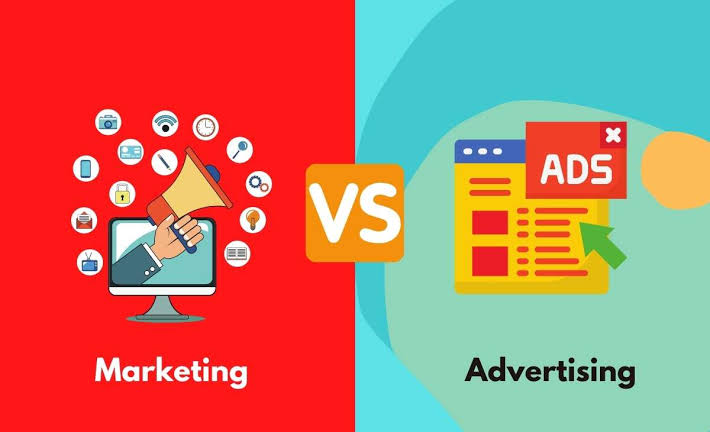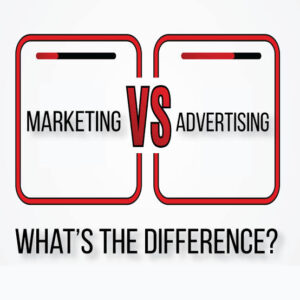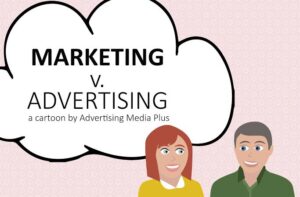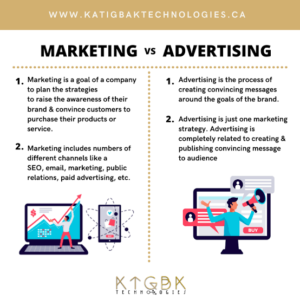
[ez-toc]
In the business world, the two-term marketing and advertising are probably the most important terms.
However, there has been some curiosity on the question, what is the difference between marketing and advertising? If you’re one of the people who doesn’t know the difference between these two terms, stick to this post till the end as I’ll be explaining the difference between marketing and advertising.
Differences Between Marketing and Advertising – What is marketing?
Marketing is a technique that tends to imprint/leave a good impression of a brand in customers’ minds that when they consider purchasing a product, the brand will be the first thing they think of. Market research is the first step in the marketing process, which starts long before the product is produced. It covers choices regarding the market for the product, its pricing and its packaging.
Additionally, marketing continues after the transaction is completed by focusing on the customer’s satisfaction. This boosts the business’s sales because the customers want to continue doing business with them. Marketing professionals strive to do this by offering after-sale services and product assurances.
The brand makes an effort to match items with consumer needs through this method. It emphasizes the necessity of:
intelligent preparation, management, and coordination, as well as product availability, pricing, and promotion
Definition of Marketing
Marketing is the process of convincing customers of the benefits of your product or service so they will ultimately purchase it. It is a branding exercise where the right product is brought to the appropriate individuals at the appropriate time and place for the appropriate cost.

Functions of Marketing
- A crucial part of the company is marketing, which does more than merely advertise products but also:
- Recognize the market environment,
- To determine the needs of the customer
- Create a product based on the demand,
- Choose the most effective media to promote the goods.
- Promote it via a variety of media.
- Price determination,
- Determine the distribution networks for the good or service,
- Develop effective public relations,
- Offer post-purchase support to meet the demands of the customer.
- Marketing strategies that work.
To succeed in the market, a marketer must first think about the four C’s before developing the four P’s by the situation.
Read More
4 C’s of marketing
1. Customer solution – every product should solve a particular problem, if not, the product won’t stay so long. Through efficient marketing, the problem needed to be solved in a particular environment will be known and this will help them in determining the necessary products.
2. Customers cost – Perfect marketing checks out how much the customers are willing to pay for a particular product and with this, they can determine the price of their product which will not affect their profit.
3. Convenience – It’s quite wise to know the right place to situate a market because this should also be considered as some customers will prefer even a costly product near them to a lesser product which is far from them.
4. Communication – communication means the language and the channel that can easily access your targeted customers. This will help in determining how you will advertise your product for a maximum outcome.
4 Ps of marketing.
It alludes to the products and services a business provides to its target market to satisfy the requirements and desires of customers. Variety, quality, design, features, brand name, packaging, and services are all important.
Price
Consumers must pay the price to obtain the goods or services. List price, allowances, discounts, payment schedules, and other factors are all addressed.
Place
Physical distribution operations help a product get from its manufacturing facility to its final destination (consumer). It covers distribution avenues, coverage, selections, locations, stock, transportation, and logistics.
Promotion
Promotion includes all of the company’s efforts to explain to the public the features, benefits, and other characteristics of its products. Its primary tools are public relations, sales promotion, personal selling, and advertising.

Difference Between Marketing and Advertising – What is Advertising?
The Latin word “advert,” which simply means to turn around, is the source of the English word “advertising.” It stands for the strategies an organization does to draw attention to a particular thing or objective. This part of the marketing process is important.
The largest and most expensive component of marketing is advertising. It is a monologue exercise done to influence an increasing number of individuals toward the good or service. Through this method, a lot of individuals can hear one message in a short amount of time.
In this procedure, the general population is exposed to spoken or visual communications. For the use of the time or space in the channel, the vendor or advertising must pay. To boost the sale of the goods, the goal is to convince the target audience to make more purchases.
It raises people’s awareness of numerous products. In other words, it is simple for people to decide what to use, wear, and eat. In addition, they can distinguish between honest and dishonest (misleading) commercials.
Definition of Advertising
Advertising refers to any form of paid, impersonal demonstration and promotion of concepts and goods by a reputable sponsor. The purpose of advertising is to propagate that concept and raise consumer awareness of the product. To put it simply, the corporation wants to make the product well-known through advertising.
Different Channels of Advertising
We have various means by which we can advertise even though some are old means but they are still functioning depending on your targeted audience. If you’re trying to target local people, the usage of video channels will be the best.
The following are types of advertising channels.
1. Video channels: this is the means of using the visual display to communicate with people and this can be done using Television broadcasts and YouTube channels.
2. Audio channels: this is the act of using sounds and voice to communicate to the audience through Radio (jingles) and podcasts which are the known channels.
3. Printed publications: is the means of using printed copies and graphics to communicate with customers through the use of Newspapers and magazines.
4. Outdoor advertising: is also a means of using printed copies but this seems more digitalized than the first because they make use of Billboard, wall painting, car branding, and many more.
5. Social Media platforms: this is the most advanced and trendy means of advertisement. Since we are in the age of technology, promoting your brands or business on social media is no doubt, the best thing to do.
Some of the popular social media used for the advertisement include Facebook, Snapchat, Twitter, Instagram, and TikTok. You can run ads on these platforms to have the best result as ads will go more viral than just random posts.

Read More
5 crucial M’s in advertising
Marketing managers strive to determine the target market and the motivations of the buyer while creating an advertising program. Then, they must decide on the following five crucial issues to build an advertising program, known as the 5 M’s:
- Mission: What goals does advertising want to achieve?
- Money: Amount needed to broadcast the advertisement across all media outlets, in total.
- Message: What would be the circulating message?
- Media: Which media platform or channel would be used to broadcast the advertisement?
- Measurement: How would the business assess the advertisement’s performance?
Differences Between Marketing and Advertising
1. Marketing is all about meeting the customers’ unmet wants. Through its offerings, it makes an effort to give customers value and satisfaction. While a recognized sponsor’s non-personal organization and composition of paid communication of ideas, products, and services are known as advertising.
2. Advertising is a subfield in marketing while Marketing is a discipline on its own.
3. Marketing is a process that includes a USP (Unique Selling Proposition) and compelling content that introduces your company. Contrarily, advertising includes the placement of advertisements on many media, including television, newspapers, billboards, radio, online advertisements, and social media.
4. The purpose of marketing is to raise public awareness of the business, its line of goods, services, and retail locations. However, the objective of advertising is to elicit a prompt and targeted response from the consumer. Visits to stores, clicks, impressions and other actions can be this response. The company’s sales will ultimately improve as a result.

5. The goal of marketing, on the other hand, is to establish the value of the company and its products in the eyes of the consumer over the long run. Advertising, on the other hand, is a short-term strategy; any advertisement that a business runs across media does so for a specific amount of time. Additionally, advertising is done with a specific goal in mind.
Let’s say the business wants to spread the word about the sale. To elicit the desired response from the audience, it will advertise the same across a variety of mediums. so that the greatest number of people as possible will hear the message.
6. The goals of marketing are to establish a market for the goods and to establish a reputation. But the goal of advertising is to grab people’s attention.
7. While marketing helps consumers become more aware of things. Advertising ensures that the company’s items generate revenue.
Conclusion
The above content is all you need to answer the question, what’s the difference between marketing and advertising?
It’s well established that marketing is so important for the success of a brand or company as the success of every firm may be evaluated by its achievement in marketing. Every business needs marketing, but not every business needs advertising unless the business plans to grow exponentially. Advertising draws customers, whereas marketing pulls them in.
Leave a Reply